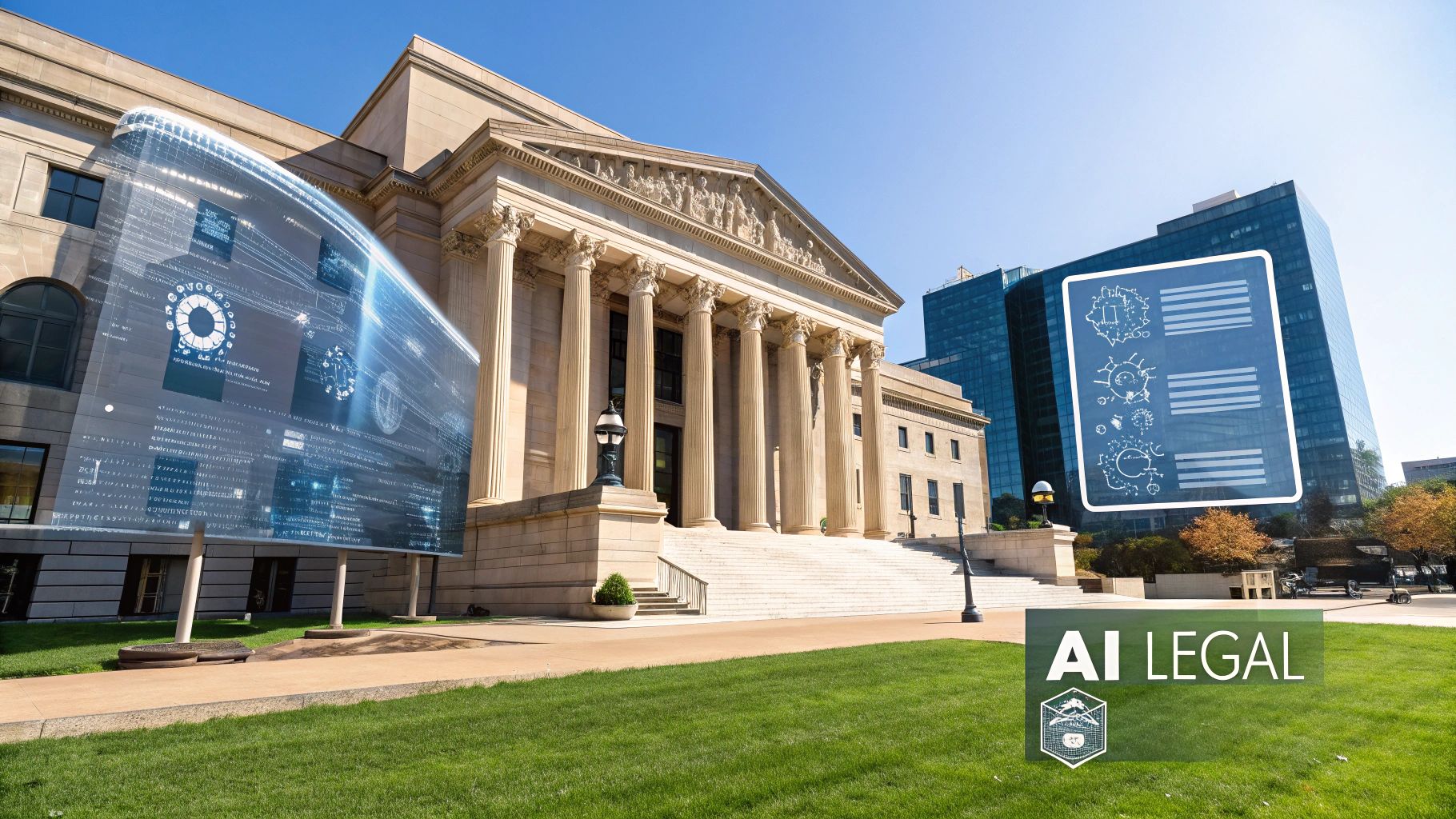Power Up Your Practice: ai legal assistance
The Evolution of AI Legal Assistance in Modern Practice

Not long ago, artificial intelligence in law seemed like a far-off concept. Now, AI is rapidly becoming a core component of modern legal practice. This shift represents a significant evolution, driven by the legal profession's increasing need for efficiency and accuracy. For more on AI in law, check out this resource: How to master AI in Law.
This growing demand for AI legal assistance is reflected in recent statistics. The American Bar Association's 2024 Legal Technology Survey Report indicates that AI adoption in legal practice has nearly tripled in a single year, increasing from 11% in 2023 to 30% in 2024. This surge highlights the recognized benefits of AI, especially for document review, research, and administrative tasks.
Larger firms are at the forefront of this trend. Currently, 46% of firms with 100+ attorneys utilize AI tools, compared to just 16% in 2023. Interestingly, solo practitioners are also embracing AI, with adoption rates rising from 0% in 2022 to 18% in 2024. The global AI legal services market, valued at $1.19 billion in 2023, is projected to expand at a 32.5% compound annual growth rate. This growth is fueled by the demand for efficient solutions that automate repetitive tasks. More detailed statistics can be found here: https://docuease.com/statistics. This rapid expansion underscores the increasing importance of AI in today's legal field.
Key Drivers of AI Adoption in Law
Several factors are accelerating the integration of AI into legal practices. The primary driver is the sheer volume of data involved in legal work. AI excels at processing and analyzing large datasets, quickly identifying critical information much faster than any human. This allows legal professionals to dedicate their expertise to strategic decision-making rather than time-consuming document review.
The mounting pressure to reduce costs and enhance efficiency also plays a significant role. AI-powered tools automate tasks like legal research and document drafting, saving considerable time and money. This allows firms to offer more competitive pricing for clients and boost their own profitability.
The Impact on Different Firm Sizes
The adoption of AI legal assistance varies across different firm sizes. While larger firms initially embraced AI solutions more readily, smaller firms and solo practitioners are now recognizing the advantages. This broader adoption suggests that AI is no longer an optional extra but a vital tool for remaining competitive, regardless of a firm's size.
To further illustrate the adoption rates across different firm sizes, let's take a look at the following table:
AI Adoption Rates by Law Firm Size
This table shows the percentage of law firms adopting AI tools based on firm size over recent years.
| Firm Size | 2022 Adoption | 2023 Adoption | 2024 Adoption |
|---|---|---|---|
| Solo Practitioners | 0% | N/A | 18% |
| Small Firms (2-10 Attorneys) | N/A | N/A | N/A |
| Medium Firms (11-99 Attorneys) | N/A | N/A | N/A |
| Large Firms (100+ Attorneys) | N/A | 16% | 46% |
As shown in the table, large firms have significantly increased their adoption of AI legal tools, demonstrating the growing trend towards incorporating AI into legal practice. Data for other firm sizes wasn't readily available in the original content.
This shift towards AI-driven legal practice offers both opportunities and challenges. While some worry about job displacement, others view AI as a powerful tool to enhance their skills and dedicate more time to high-value work. As the legal profession continues to adapt, the effective use of AI will likely become a key factor for success.
High-Impact Applications of AI Legal Assistance

AI is rapidly changing the legal field. It's no longer a futuristic concept but a practical tool reshaping how legal work is done. Several key applications of AI legal assistance offer distinct advantages.
One example is document review and analysis. Traditionally, this labor-intensive process consumed much of an associate's time. Now, AI significantly accelerates document review, allowing legal professionals to focus on higher-level work like strategy and client interaction.
AI-powered legal research automation tools are also transforming case preparation. These tools can analyze vast legal databases, quickly identifying relevant precedents and saving countless hours of manual research. This increased efficiency leads to more thorough case preparation and a deeper understanding of the legal issues involved.
Contract management tools driven by AI are revolutionizing transactional practices. They automate contract drafting, review, and negotiation, ensuring accuracy and consistency while minimizing errors. This streamlines the contracting process and allows attorneys to focus on strategic deal-making. You might be interested in learning more: How to master Legal Document Automation.
Predictive Analytics and Client Intake
AI is also impacting other areas of legal practice. Predictive analytics, for instance, provide valuable insights for litigation strategy. By analyzing historical data and case outcomes, AI can assess the likely success of various legal arguments, helping attorneys make informed decisions and increasing the chances of a favorable outcome.
AI-powered client intake systems help firms capture new business, even outside of normal business hours. These systems automate initial consultations, gather client information, and schedule appointments, ensuring potential clients receive prompt attention. This automation, combined with the increasing use of AI in document recording and client intake, is prompting firms to re-evaluate traditional billing models.
The following table highlights the potential impact of AI automation on various legal tasks:
The table below, "Legal Tasks Most Impacted by AI Automation," compares legal tasks based on their potential for automation, average time savings, and complexity level. This comparison offers a glimpse into how AI is reshaping legal workflows.
| Legal Task | Automation Potential | Average Time Savings | Complexity Level |
|---|---|---|---|
| Document Review | High | 60-80% | Medium |
| Legal Research | High | 50-70% | Medium |
| Contract Drafting | Medium | 30-50% | Medium |
| Client Intake | Medium | 20-40% | Low |
| Predictive Analysis | Medium | 20-40% | High |
As this table illustrates, tasks like document review and legal research hold significant potential for time savings through automation, while other tasks, like predictive analysis, may involve greater complexity despite their automation potential.
A 2024 Clio Legal Trends Report shows that AI adoption among legal professionals increased significantly, from 19% in 2023 to 79% in 2024. The report also found that 74% of hourly billable tasks are now automatable. This aligns with Goldman Sachs' 2023 projection that AI could automate 44% of legal work, potentially impacting 40% of industry jobs. For more information on these statistics, see this article: AI Adoption in Legal Profession. This shift underscores the growing importance of AI in the future of legal practice.
Implementing AI Legal Assistance Without Disruption
Many firms hesitate to adopt AI legal assistance due to concerns about the challenges of implementation. This section provides a practical guide for integrating AI seamlessly, based on successful implementations in firms of all sizes.
Assessing Your Firm's Needs
The first step is to thoroughly assess your firm's needs. Pinpoint the specific areas where AI can deliver the greatest value. For instance, if document review consumes a significant amount of time, prioritize AI-powered document review tools. If legal research is a bottleneck, focus on AI research platforms like Lex Machina. This targeted approach ensures that you select the tools that directly address your firm’s pain points.
Evaluating AI Solutions
The market offers a wide array of AI legal tools. Carefully evaluate the available solutions based on your identified needs. Consider factors such as features, ease of use, integration capabilities, and security. A clear understanding of your requirements will guide you in selecting the right tools for your firm.
Planning for Seamless Implementation
Effective implementation hinges on careful planning. This involves developing a phased rollout plan, providing adequate staff training, and anticipating potential data migration challenges. For example, start with a pilot program in a specific practice area before deploying firm-wide. This allows for refinement and minimizes disruption.
Overcoming Common Roadblocks
Implementation often faces resistance. Address staff concerns about job security and provide training to build confidence in using the new tools. Data migration from existing systems can also present challenges. Ensure compatibility and develop a robust data migration strategy to prevent data loss or corruption. Seamless integration with current systems is also crucial. Choose tools that integrate easily with your existing software to avoid workflow disruptions.
Timelines, Budget, and Key Performance Indicators
Establish realistic timelines for implementation, factoring in potential delays. Develop a clear budget that encompasses software costs, training expenses, and ongoing maintenance. Finally, define Key Performance Indicators (KPIs) to measure the success of your AI implementation. These could include metrics such as time saved on document review, improved accuracy in legal research, and increased client satisfaction. By tracking these metrics, you can validate your investment and demonstrate the value of AI legal assistance to your firm. This methodical approach helps replace impulsive technology adoption with a strategic implementation plan that delivers lasting results.
Navigating Ethical Considerations With Confidence

The rise of AI legal assistance presents exciting opportunities. However, it also requires careful consideration of the ethical implications. Instead of avoiding these complexities, the legal profession must address them proactively. This involves understanding and mitigating potential risks related to algorithmic bias, data confidentiality, and evolving disclosure obligations. Learn more about security best practices in our article about How to master security awareness training topics.
Addressing Algorithmic Bias
AI algorithms learn from data. If that data reflects existing societal biases, the algorithm may perpetuate or even amplify them. In the legal field, this can lead to unfair or discriminatory outcomes.
For example, an AI tool used for sentencing recommendations could unfairly penalize certain demographic groups. This might occur if the training data reflects historical biases in sentencing. It's crucial to ensure the training data for AI legal tools is diverse and representative. This helps mitigate the risk of algorithmic bias. Ongoing monitoring and evaluation of AI systems are also necessary to identify and correct biases that may emerge.
Maintaining Confidentiality in the Cloud
Many AI legal tools use cloud-based platforms for data storage and processing. This raises valid concerns about data confidentiality, especially considering the sensitive nature of legal information. Robust security measures are essential to protect client data.
These measures could include encryption, access controls, and regular security audits. These are critical components of a secure cloud-based AI legal system. Lawyers have an ethical obligation to ensure client data is handled securely. This includes thoroughly vetting any cloud-based AI providers they use.
Evolving Disclosure Obligations
Using AI in legal practice raises important questions about disclosure. Should lawyers disclose their use of AI tools to clients and courts? What level of detail is required? These are developing areas of legal ethics, and clear guidelines are still emerging.
Transparency is generally recommended. Lawyers should consider informing clients about their use of AI. They should also explain how it might impact their representation. Similarly, courts may require disclosure of AI usage, particularly if it significantly influences legal strategy or case outcomes.
Best Practices and Case Studies
Leading law firms are developing best practices for the ethical implementation of AI. These practices often include:
- Establishing internal ethics committees to review AI usage
- Developing clear guidelines for data security and confidentiality
- Providing ongoing training for staff on the ethical considerations related to AI
Examining case studies of unexpected ethical dilemmas and their resolutions can offer valuable lessons. These real-world examples provide practical guidance for navigating the complex ethical landscape of AI legal assistance. By proactively addressing these ethical considerations, the legal profession can ensure AI is used responsibly and ethically, enhancing access to justice and improving legal services.
Reimagining Your Economic Model With AI Assistance
The rise of AI legal assistance presents a fundamental challenge to the traditional billable hour model. As AI significantly reduces the time spent on tasks like document review and legal research, billing solely for hours worked is becoming less sustainable. However, forward-thinking firms are embracing this shift as an opportunity to create innovative and more effective economic models.
One such model is value-based pricing. This approach prioritizes the value delivered to the client, rather than the time spent on a task. For instance, instead of billing for hours spent drafting a contract, a firm could charge a fixed fee based on the contract's complexity and overall value. This provides clients with predictable costs and encourages firms to leverage AI for maximum efficiency. You might be interested in: How to master practice management solutions.
Another promising model is subscription legal services. Much like software subscriptions, clients pay a recurring fee for access to a pre-defined set of legal services. This ensures consistent revenue for the firm and predictable legal expenses for the client. AI can play a vital role in delivering these services efficiently, enabling firms to serve a broader client base.
Hybrid Models and ROI Analysis
Many firms are implementing hybrid models, combining aspects of traditional hourly billing with value-based pricing or subscriptions. This allows for a smoother transition and caters to the diverse needs of various clients and practice areas. Analyzing the return on investment (ROI) of AI implementation is critical for making well-informed decisions about new economic models. This includes assessing both the initial costs of implementing AI tools, like software licenses and staff training, and the long-term financial benefits, like increased efficiency and reduced labor costs.
The Human Element: Redefining Roles
While AI can automate numerous tasks, the human element remains crucial within the legal profession. Instead of eliminating jobs, progressive firms are redefining roles to concentrate on higher-value work requiring human expertise. This includes areas such as strategic advising, client relationship management, and complex legal analysis.
New Value-Added Services
AI empowers lawyers to provide new value-added services. For instance, AI-driven predictive analytics can provide clients with insights into the potential outcomes of litigation, facilitating better decision-making. This transforms the lawyer’s role from simply reacting to legal issues to proactively advising clients on potential risks and opportunities.
Compensation Structures that Reward Efficiency
Finally, rethinking the economic model necessitates revisiting compensation structures. Firms need to create compensation models that reward efficiency and effective AI utilization without discouraging productivity. This might involve incorporating metrics related to value delivered, client satisfaction, or the successful implementation of AI tools into performance reviews and bonus structures. This encourages lawyers to embrace AI and contribute to the firm’s evolving economic model. By embracing these adaptations, law firms can not only address the challenges presented by AI but also unlock new avenues for growth and enhanced client service.
Securing Your Future in an AI-Enhanced Legal Landscape

The integration of AI legal assistance is reshaping the legal profession. It's not simply a passing trend, but a fundamental change in how legal services are provided. This shift requires a proactive approach – anticipating and shaping the future, rather than just reacting to it. For a deeper understanding of what's to come, explore this insightful article: AI-Powered Legal Tech Software 2025.
Beyond Current Limitations: The Evolution of NLP
Natural language processing (NLP) is at the forefront of this transformation. Current AI tools excel at tasks like document review. However, future NLP advancements promise even greater accuracy in understanding and interpreting legal nuances. This means AI can handle more complex tasks, such as legal drafting and negotiation, allowing lawyers to focus on strategic decision-making.
Predictive Justice and Litigation Strategy
Predictive justice models are another significant development. By analyzing vast datasets of legal information, these models can predict the likely outcomes of legal cases. This is crucial for developing litigation strategies, assessing risk, and providing informed counsel to clients. However, it's essential to use these models carefully, acknowledging potential biases within the data.
The Expanding Capabilities of Automated Legal Reasoning
AI-powered tools are rapidly advancing in automated legal reasoning. Currently, they can analyze legal documents and identify relevant clauses or precedents. Future developments will enable AI to analyze complex arguments, identify logical fallacies, and even suggest alternative strategies, significantly enhancing legal research and analysis.
Practical Guidance for Maintaining Competitive Advantage
In this evolving legal landscape, law firms must adopt a strategic approach to AI legal assistance. Here’s how:
- Staying Informed About Regulatory Developments: New regulations and ethical guidelines surrounding AI in legal practice are expected. Firms must remain up-to-date to ensure compliance and mitigate legal challenges.
- Investing in Skill Development: Lawyers need new skills to effectively use AI tools. This includes training in areas like data analysis, AI ethics, and legal technology, ensuring they're prepared for evolving roles.
- Balancing Technological Efficiency with Human Expertise: While AI can automate many tasks, human expertise and judgment remain invaluable. Firms must strike a balance between leveraging technology and preserving the human element that clients value.
Capturing Opportunities While Mitigating Concerns
The future of law is inextricably linked with AI. Embracing these advances can streamline workflows, enhance client service, and provide a competitive edge. However, addressing concerns around algorithmic bias and data security is crucial for responsible and ethical AI implementation.
Ready to experience the future of legal document creation and management? Visit Whisperit today to learn more about our AI-powered dictation and text editing platform. Streamline your workflow, enhance security, and boost productivity with Whisperit.